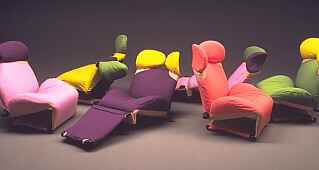|
|

design practice and theory
CLICK THE RED DOTS IN THE LOGO TO OPEN NEW PAGES AT RANDOM |
|
|

design practice and theory
CLICK THE RED DOTS IN THE LOGO TO OPEN NEW PAGES AT RANDOM |
 |
||
| a group of Kita's Wink Chairs by Cassina from 1980 | ||
| In this example we can see that the legs, be it one central with five feet, as in Eames' Lounge Chair, or the four traditional legs that support most easy chairs such as the Red blue Chair of Rietveld, or two bent pipes, as in Breuer's Wassily Chair, are not fundamental or essential for the definition of the category of Modern Classic Easy Chairs. The general definition of the product sector should therefore rather identify the inclined sitting posture as defined by Kita's connational Ohara. | ||

the easy sitting posture defined by Ohara |
||
| In one important aspect the Wink Chair differs from other easy chairs:
it is somewhat lower. This corresponds to the more relaxed sitting posture
of modern, young, people and, not casually, also to sitting habits of orientals.
Thus the height of the weight baring point, a triangle in the drawing,
is relative in the definition of Modern Easy Chairs. The softness
and the elasticity of the upholstery, though important to comfort,
is also not considered essential as we can see in the Rietveld
red blue chair
limiting the definition to the size and inclination of seat, back and headrest. |
| want to know more about Modern Easy Chairs? look at the following links: |
| look at other chairs |
| back to Modern Classic Easy Chairs |
| Next page is about symbols in design |
| about the modular grid the meaning of colors in Rietvelds chair |
| back to the general analysis of Rietveld's chair |
|
|
|
|
|
|